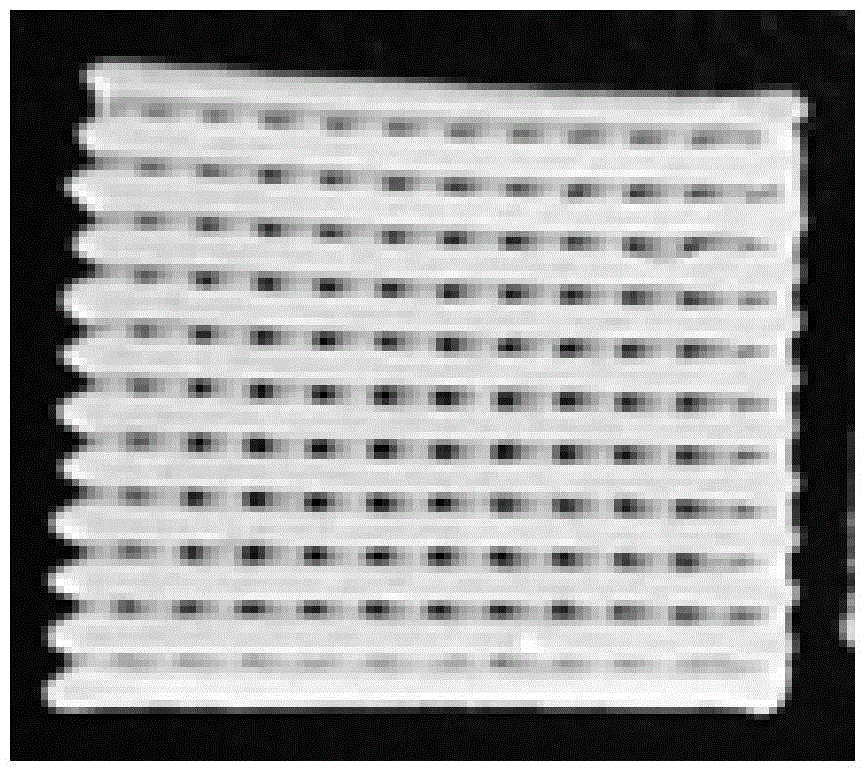Normal forming method for sodium alginate containing three-dimensional scaffold
A technology of sodium alginate and a molding method, applied in the field of bioengineering, can solve problems such as unfavorable promotion and application of three-dimensional printing technology, inactivation of growth factors and cells, harsh molding conditions, etc. mild conditions
- Summary
- Abstract
- Description
- Claims
- Application Information
AI Technical Summary
Problems solved by technology
Method used
Image
Examples
Embodiment 1
[0030] A normal molding method of a three-dimensional support containing sodium alginate, comprising the following steps:
[0031] (1) Preparation of a three-dimensional scaffold containing sodium alginate
[0032] Dissolve 3g of sodium alginate in deionized water to obtain a sodium alginate solution with a mass concentration of 10%, then add 1g of PVA, stir evenly at 90°C as a printing slurry; then use the slurry as a three-dimensional printing slurry, and use the printer ( The Bioscaffolder printer produced by Gesim, Germany) was printed at room temperature to obtain a three-dimensional bracket containing sodium alginate. The specific parameters of the bracket were that the side length of the bottom surface of the bracket was 15 mm, the height was 6 mm, and the row spacing range of the bracket was 1.15 mm;
[0033] (2) Molding
[0034] Soak the printed three-dimensional scaffold containing sodium alginate in a calcium chloride solution with a concentration of 0.5 mol / L over...
Embodiment 2
[0036] A normal molding method of a three-dimensional support containing sodium alginate, comprising the following steps:
[0037] (1) Preparation of a three-dimensional scaffold containing sodium alginate
[0038] Dissolve 4g of sodium alginate in deionized water to obtain a sodium alginate solution with a mass concentration of 10%, then add 1g of bioactive glass and 1.67g of PVA, and stir at 90°C to obtain a slurry; then, use the slurry as a three-dimensional The printed slurry is printed under normal temperature by a printer (the Bioscaffolder printer produced by Gesim, Germany) to obtain a three-dimensional support containing sodium alginate. The distance between bracket rows is 1.15mm;
[0039] (2) Molding
[0040] Soak the printed three-dimensional scaffold containing sodium alginate in a calcium chloride solution with a concentration of 5 mol / L overnight at room temperature, wash three times with deionized water after soaking, and freeze-dry to constant weight to obta...
Embodiment 3
[0043] A normal molding method of a three-dimensional support containing sodium alginate, comprising the following steps:
[0044] (1) Preparation of a three-dimensional scaffold containing sodium alginate
[0045] Dissolve 2g of sodium alginate in deionized water to obtain a sodium alginate solution with a mass concentration of 10%, then add 1g of bioactive glass and 1g of PVA, and stir at 90°C to obtain a slurry; then, use the slurry as a three-dimensional printing The slurry is printed with a printer at room temperature to obtain a three-dimensional support containing sodium alginate. The specific parameters of the three-dimensional support containing sodium alginate are that the side length of the bottom surface of the support is 15 mm, the height is 6 mm, and the row spacing range of the support is 1.15 mm;
[0046] (2) Molding
[0047] Soak the printed three-dimensional scaffold containing sodium alginate in a calcium chloride solution with a concentration of 0.5 mol / L ...
PUM
| Property | Measurement | Unit |
|---|---|---|
| Bottom side length | aaaaa | aaaaa |
| Height | aaaaa | aaaaa |
| Line spacing | aaaaa | aaaaa |
Abstract
Description
Claims
Application Information
 Login to View More
Login to View More - Generate Ideas
- Intellectual Property
- Life Sciences
- Materials
- Tech Scout
- Unparalleled Data Quality
- Higher Quality Content
- 60% Fewer Hallucinations
Browse by: Latest US Patents, China's latest patents, Technical Efficacy Thesaurus, Application Domain, Technology Topic, Popular Technical Reports.
© 2025 PatSnap. All rights reserved.Legal|Privacy policy|Modern Slavery Act Transparency Statement|Sitemap|About US| Contact US: help@patsnap.com

